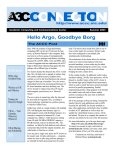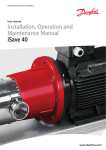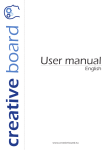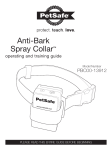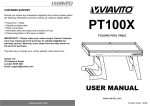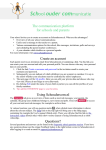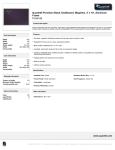Download Dog and Bone - Amplitude game
Transcript
May 20th, 1996 TIDE Project 1060 HARP An Autonomous Speech Rehabilitation System for Hearing Impaired People FINAL REPORT Annex D User Training Manual Version 1.1 Contents Introduction 3 Amplitude games: Dog and Bone Smiley face 4 5 Pitch and intonation games: Spinning ball Flashing light bulb Pitch Aeroplane Chalkboard 6 7 8 10 Vowels : Real-time vowel displays 11 Consonants: S-Sh real-time feedback Animated examples 13 14 2 Introduction This annex includes a draft version of the HARP System User Training Manual, which forms a supplement to Deliverable D6, “HARP Courseware”. It comprises user manual sections for four areas of the HARP courseware, namely the Pitch, Loudness, Vowel and Consonant modules which together form the Beta-Release version of the Courseware. These modules were chosen for beta release on the basis of the results of the User Trials (see Deliverable D9-D12, “HARP User Trials”), as being the most robust and most suitable for immediate release. In order to allow therapists to run the software on medium-powered PCs and without a CD ROM player available (such as laptops) the video help system and some of the games using power demanding processing are not included. However these modules cover all the aspects of speech rehabilitation that were available on the complete system, and include some of the suggestions made by the therapists during the trials. Most of the modules were also optimized for speed. The document is expected to evolve and develop as users’ experience of the HARP system courseware increases, and future versions of this manual will be released from time to time. The modules included in this release are the following: Amplitude games Dog and Bone: a cheerful game for practicing loudness control. It motivates the client to mantain the loudness in the middle of the range. Smiley face: a self-explaining game for practicing loudness control. Pitch and intonation games Spinning ball: used with sustained sounds, gives an intuitive idea of pitch relating it to the speed of a spinning ball. Flashing light bulb: used with sustained sounds, relates pitch with flash rate. Pitch Aeroplane: a versatile game for practicing different pitch contours with sustained sounds. Chalkboard: gives a detailed pitch track for practicing intonation in real words and phrases. Vowels Real-time vowel displays: three real-time displays for practicing sustained vowels. Consonants: S-Sh real-time feedback: an animation of the vocal tract controlled by your voice. Animated examples: a collection of animations showing how to produce selected consonants. 3 Dog and Bone - Amplitude game Application: Voice level control. Description: The size of the bone is proportional to the voice level. However, to motivate the client in producing a “medium” voice level (not too soft, not too loud), the dog looks happier (and barks!) when the bone is of medium size. If the voice is too loud, the bone goes away and the dog looks worried. Use: Speak to start. Optional settings: A slider can be used to adjust appropriately the sensitivity, for example, for compensating the distance from the microphone. Note: The response time of the system is slightly smoothed, to avoid too rapid changes in the bone size. 4 Smiley face - Amplitude game Application: Voice level control. Description: An animated face gives the idea of the voice level by changing its size and by putting its hands near its ears. A text on the left of the face also indicates if the voice level is too low or too aloud. Use: Speak to start. Optional settings: • A slider can be used to adjust appropriately the sensitivity, for example for compensating the distance from the microphone. • A “smooth” checkbox controls the response time. 5 Spinning ball - Pitch game Application: Pitch control using sustained vowels. Description: The ball spins faster or slower with your pitch. Use: Press the “play” button and speak to start. Optional settings: A slider can be used to adjust the pitch range appropriate for the client. Note: The fundamental frequency value is displayed both as a blue line on the side of the slider and in Hz under the slider. In case of too low a voice level, instead of the frequency in Hz the text “No voice” appears. 6 Flashing light bulb - Pitch game Application: Pitch control using sustained vowels. Description: The light bulb flashes faster or slower with your pitch. Use: Press the “play” button and speak to start. Optional settings: A slider can be used to adjust the pitch range appropriate for the client. Note: The fundamental frequency value is displayed both as a blue line on the side of the slider and in Hz under the slider. In case of too low a voice level, instead of the frequency in Hz the text “No voice” appears. 7 Pitch Aeroplane Application: Pitch control, intonation. Description: The plane flies up or down with your pitch, leaving a trail of smoke if the voice level is loud enough. If the plane hits the ground, it bursts in flames, but it keeps on going. Different backgrounds may be chosen to practice different intonation patterns. Furthermore, intonation patterns can be drawn by the therapist. Use: • • Press the “play” button and speak to start. To select a background with a different intonation pattern, press one of the small buttons on the right side. The following patterns are available: 1. 2. 3. 4. 5. 6. Flat Raising Lowering Raising - lowering Lowering - raising Cartoon 1 (Park) 8 7. 8. • Cartoon 2 (Nessie) Cartoon 3 (Dinosaur) To draw a contour, press the left mouse button on the background and move the mouse while keeping the button pressed. To erase the drawing, select a background with one of the small buttons on the right. Optional settings: A slider on the left side can be used to adjust the pitch range appropriate for the client. 9 Chalkboard - Intonation game Application: Pitch control and intonation using words and phrases. Description: A pitch track is displayed on the chalkboard just after the end of an utterance. Different pitch tracks of different width can be overlapped, so that a thick track (produced by the therapist) can be used as a model for the client. The pitch tracks are normalised in time, so that both a short or a long utterance fill the chalkboard. Use: • • • • Choose one of the chalks by pressing one of the buttons on the top left side of the chalkboard, and speak to start. The pitch track will appear just after the end of the utterance. To clear the chalkboard press the “Clear” button. To keep the track of the last utterance, press the “Keep last” button. That track will stay on the chalkboard (redrawn in a thin purple) even if the “Clear” button is pressed. To erase it, press “Clear” twice. To save or retrieve tracks from the disk, use the icons on the right side of the chalkboard. Optional settings: A slider on the left side can be used to adjust the pitch range appropriate for the client. 10 Real-time vowel displays Application: Sustained vowels Description: While the client produces sustained vowels a pointer moves on a screen showing one of the following: • the vowel produced by the client versus reference vowel targets • the (approximate) position of the tip of the tongue inside the vocal tract • the vowel produced by the client versus “example” targets that can be moved by the therapist. Use: • • • Select the sex and the language/accent from the menu on the top. Select one of the three displays (movable targets, vocal tract, reference targets) from the “Display” menu on the top. Produce a sustained vowel to move the pointer. 11 The “movable targets” are useful when the therapist wants to make things easier for the client, leaving on the screen only the targets of the vowel of interest and possibly moving those targets in a position not too difficult to reach. In the above picture, only three targets are used, (all the others were moved in the bottom of the screen). To move a target press the left mouse button on the selected target and drag it in place without releasing the button. The “vocal tract display” shown above displays approximately the position of the tip of the tongue inside the vocal tract. The symbols on the right side can be dragged on the vocal tract as a reference point. 12 Consonants: S-Sh real-time feedback Application: Control of the correct production of /s/ and /sh/ Description: Assuming that a /s/ or /sh/ sound is produced, an animation of the vocal tract shows approximately the tongue shape. The two meters on the right side show: (top) an indication of the “centre of gravity” of the voice spectrum, in Hz, and (bottom) an indication of the voice level. Use: Produce a /s/ or /sh/ sound to see the animation moving accordingly. Check that the loudness meter shows a level high enough (the needle is about in the middle of the scale). 13 Consonants: animated examples Application: Pronunciation of selected consonants. Description: These animations show dynamically the vocal tract when producing selected consonants. Use: Play the videoclips, and optionally pause or move the slider to seek the requested position. 14














